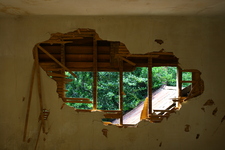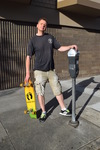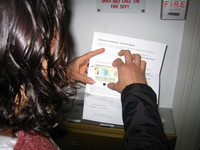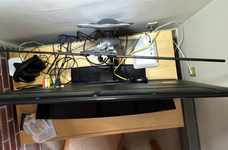 |
| Angelika/Mike Schilli |
|
Michael In Germany, to put a picture frame up on the wall, renters break out the hammer drill, to go through common brick walls like butter, then insert a plastic anchor in the hole and a screw, and up goes the frame, solid as a rock, forever and a day, regardless of what happens around it. Not so in America, where most houses aren't made of bricks, but built by nailing half-inch-thick slates of drywall onto wooden 2x4 studs and calling the result "house" (figure 1). You might think I'm pulling your leg here, but that's the honest truth. It's done this way mostly because it's cheap, but in the San Francisco Bay Area it's actually a safety measure, because of the constant earthquakes. Wood is flexible and bounces back, while bricks crumble and crush occupants.
You can imagine what happens to a picture frame hanging by a single nail sticking in a half-inch thick cardboard: It won't last long on the wall and will drop sooner or later when the nail loses its grip. Living in such a house of cards, instead of simply driving the nail into the drywall, you need to find the vertical wooden stud the drywall was nailed onto, to drive the nail through the drywall and right into the wooden stud, where it sits rock-solid. But how do you find these studs, which are hidden invisibly in the wall, spaced out with 16 inches in between them? You can't look through the drywall, obviously, but this is the country of great inventions, which is why you can find gadgets at every hardware store to solve the problem.
So-called "stud finders" probe the wall and light up when they detect a stud inside. The electrical variant works similar to a metal detector and starts blinking if the location is suitable for driving in a nail or screw. However, less commonly known, but a lot cheaper and even more effective are magnetic variants of the tool. They make use of the fact that studs usually contain metal nails spaced out evently, after all, someone must have nailed drywall sheets onto them when the house was built. These magnetic tools don't need a battery, they simply use a strong magnet which gets pulled towards metal in the wall, making the tool stick to the wall in locations where there's both a nail and a stud underneath. Genius! And it's very handy if you want to mark the stud location with a pencil on the wall. Since you don't know how far the nails are up or down the stud, drawing S-figures with the tool will sooner or later reveal a nail, and therefore the location of the stud it was hammered into. Now another nail or screw can be hammered into the wall above or below the trigger location and it is then guaranteed to land in the sturdy stud and not some loose piece of drywall.
I can recommend two devices I've had good success with: The Franklin ProSensor 710+ is quite expensive at \$50, and therefore only within reach for high rollers like myself, but I like its row of LEDs and how some of them light up in a moving pattern while you move over the wall, indicating where the stud is located at. But really all you need is a magnetic stud finder which only costs around \$10, like the "CH Hanson 03040". As the tool sticks to the wall when it finds a nail, you can use its sides as a ruler while you mark the position with a pencil, or start drilling right away. Stay away from devices made by "Zircon", I've found that they give lots of false positives and the correlation between the device blinking and a stud being present is random at best.














